Hurricane Dorian lashes US as Bahamas counts cost

From BBC
Hurricane Dorian is expected to bring “life-threatening storm surges” up the US east coast after causing destruction and at least 20 deaths in the Bahamas.
The category three storm is currently lashing the coast of the Carolinas as it moves slowly north. Tens of thousands of people are without power.
Residents from Georgia up to Virginia are being warned to listen to emergency advice.
Dorian weakened after hitting the Bahamas but has now strengthened again.
It currently has maximum sustained winds of 115mph (185km/h).
On 1 September it hit the Bahamas with winds of up to 185mph (298km/h) – equalling the highest ever recorded at landfall. It battered the Abaco Islands and Grand Bahama, in the north of the archipelago, for two days.
Bahamas PM Hubert Minnis called the storm “one of the greatest national crises in our country’s history”. He expected the number of fatalities to increase.
What’s the latest on the storm?
The US National Hurricane Center (NHC) said that at 09:00 GMT Dorian was 130km (80 miles) south-east of Charleston and moving north at about 13km/h (8mph).
The NHC said Dorian “continues to lash the coast of the Carolinas. Hurricane conditions are likely over portions of the area later on Thursday”.
It is expected to turn north-east later on Thursday and speed up.
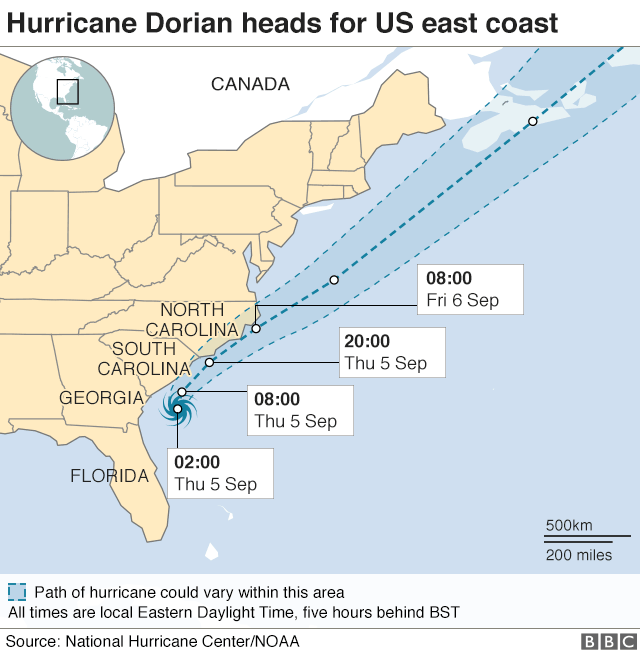
South Carolina has prepared for a record storm surge and the effects are already being felt. More than 100,000 people were without power in coastal areas on Thursday morning, energy officials said.
Social media footage showed flooding in central Charleston.
Dorian is forecast to move close to the coast of South Carolina on Thursday, then “near or over” the coast of North Carolina overnight and on Friday.
Graphics showed waters could rise up to 8ft (2.4m) above ground level on the South Carolina coast, and up to 15in of rain could fall in the coming days.
“Time to get out is running out,” the state’s governor Henry McMaster told reporters.
More than 2.2 million people have been ordered to evacuate along the eastern seaboard.
US President Donald Trump earlier held up a map incorrectly suggesting Dorian could hit Alabama. Some observers said it looked as though a line around the state was drawn with a felt pen.
The president has since said he did not know why the chart showed this.
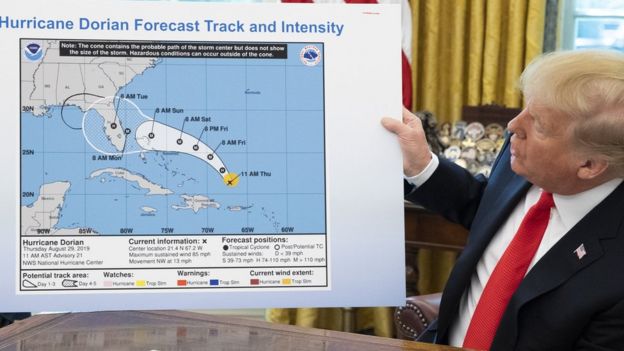
Presidential candidate Marianne Williamson meanwhile earlier suggested on Twitter that prayer could drive the storm away. She defended her now-deleted tweet, claiming that those praying should not be treated with “mockery or condescension”.
Mile upon mile of destruction
Aleem Maqbool, BBC News, the Abaco Islands
We’ve heard about the record-breaking strength of Hurricane Dorian for days now but to see the impact on the ground is staggering.
Roofs just lifted up and slammed to the ground, buildings all but destroyed. Having flown over the Abaco Islands, I can tell you there is mile upon mile of this.
The northern Bahamas have borne the brunt of the storm’s ire and this is where in the coming days the humanitarian needs are going to be acute.
What’s the latest in the Bahamas?
Although Grand Bahama suffered severe damage and floods, the Abaco Islands were hardest hit. Footage taken from the air showed vast swathes of destruction. Homes, roads and businesses were torn apart, and high waters remain.

Health Minister Duane Sands told the Washington Post 17 had died in the Abaco Islands and three on Grand Bahama. These figures are reportedly expected to rise as rescuers search through the devastated country.
“There’s nothing left in most of Marsh Harbour,” said Alicia Cook, who evacuated from the area in the Abaco Islands. “People are starting to panic: pillaging, looting.”
Bob Cornea also spoke to the BBC in the capital Nassau after being evacuated from Marsh Harbour. He said he and his wife had taken shelter on the second storey of their son’s house.
“Water was up to my neck. It stayed like that for two or three hours… My son… he got us out and we got over to safety.
INTERACTIVE Slide to see damage to harbours and homes in Marsh Harbour, Abaco Islands
4 September
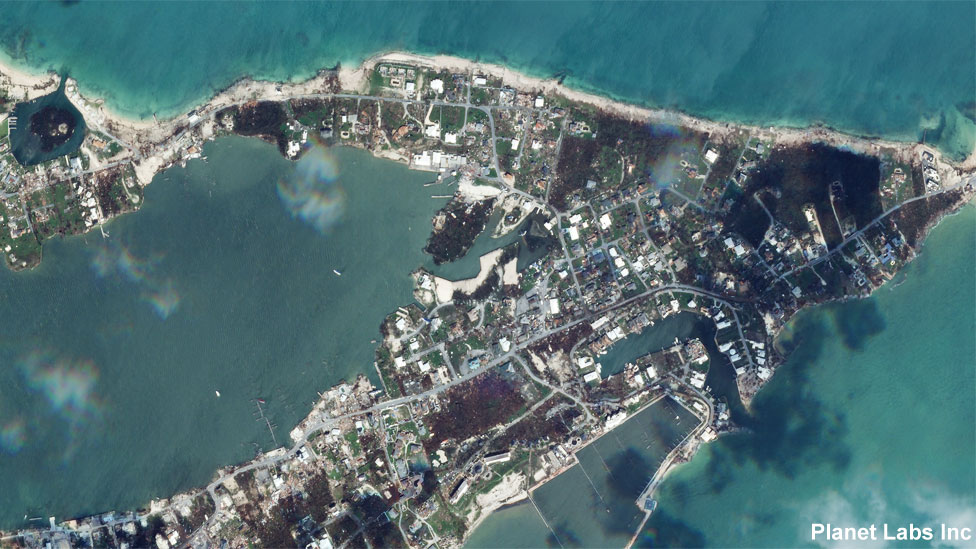
29 May
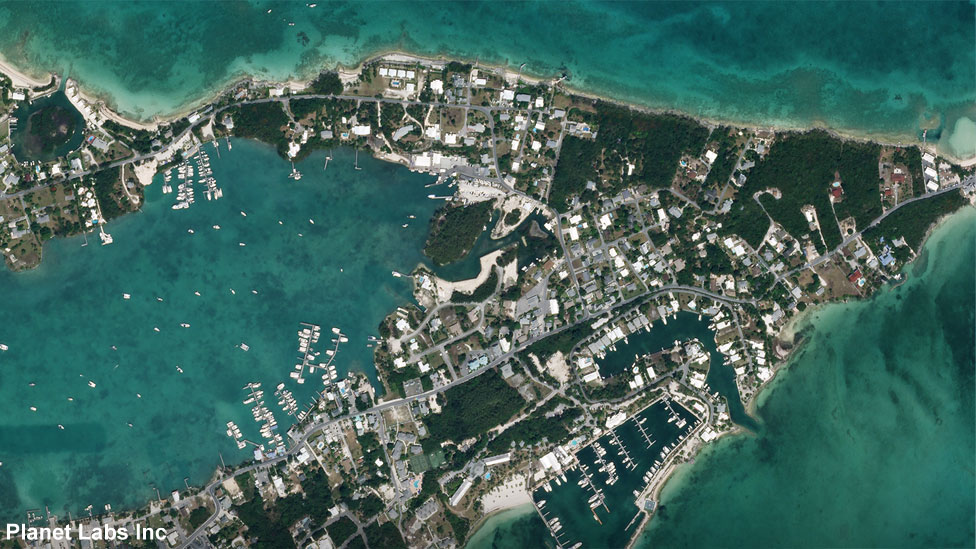
“We’ve been through all kinds of hurricanes, all kinds of storms: never anything that bad. I mean, it was like we were standing in the middle of the ocean. That’s what it looked like. Waves, the water just crashing in over us. Horrifying. Absolutely horrifying.”
The British Royal Navy vessel RFA Mounts Bay has begun landing personnel and emergency aid to the Abacos. Helicopters and three UK humanitarian experts have been helping to co-ordinate the rescue response.
INTERACTIVE See extent of flooding in Abaco Islands caused by Hurricane Dorian
After Dorian
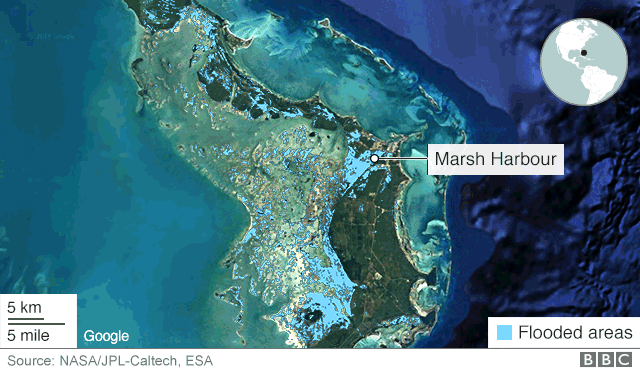
Before Dorian
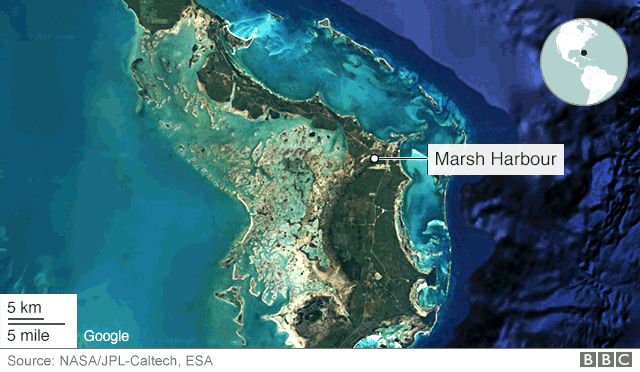
Bringing in aid to Grand Bahama has been hampered by severe damage to its airport.
The International Red Cross fears 45% of homes on Grand Bahama and the Abacos – some 13,000 properties – were severely damaged or destroyed.
Some 70,000 people are in “immediate need” of aid, UN officials said.
Is climate change making hurricanes worse?
Scientists cannot say whether climate change is increasing the number of hurricanes, but the ones that do happen are likely to be more powerful and more destructive because of our warming climate, says BBC Weather’s Tomasz Schafernaker.
Here’s why:
- An increase in sea surface temperatures strengthens the wind speeds within storms and also raises the amount of precipitation a hurricane will dump
- Sea levels are expected to increase by one to four feet over the next century, bringing the potential of far worse damage from sea surges and coastal flooding during storms
For more on this story and video go to: https://www.bbc.com/news/world-us-canada-49588680





